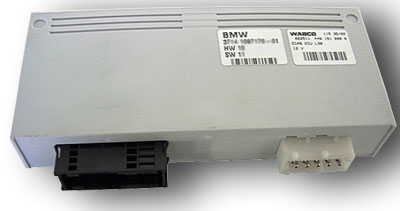| C0867 |
 |
| 1 |
Not used |
| 2 |
CAN bus high |
| 3 |
Control switch up selection |
| 4 |
Control switch hold selection |
| 5 |
Control switch motorway ride height LED |
| 6 |
Front RH corner valve control |
| 7 |
Front LH and RH conrner control valves power supply |
| 8 |
Front LH corner valve control |
| 9 |
Rear RH corner valve control |
| 10 |
Rear LH and RH corner valves power supply |
| 11 |
Rear LH conrner control valve |
| 12 |
Reservoir valve control input |
| 13 |
Reservoir valve power supply |
| 14 |
Exhaust pilot valve power supply |
| 15 |
Exhaust pilot valve control |
| 16 |
Air suspension relay control |
| 17 |
High pressure exhaust valve power supply |
| 18 |
Not used |
| 19 |
Not used |
| 20 |
CAN bus low |
| 21 |
Control switch down selection |
| 22 |
Control switch off-road ride height LED |
| 23 |
Control switch access ride height LED |
| 24 |
Front RH height sensor signal |
| 25 |
Front LH height sensor signal |
| 26 |
Rear RH height sensor signal |
| 27 |
Rear LH height sensor signal |
| 28 |
Air pressure sensor signal |
| 29 |
Not used |
| 30 |
Not used |
| 31 |
Temperature sensor |
| 32 |
Front LH height sensor power supply |
| 33 |
Front RH height sensor power supply |
| 34 |
Air pressure sensor power supply |
| 35 |
High pressure exhaust valve control |
| 36 |
Not used |
| 37 |
K Bus |
| 38 |
Wake up signal |
| 39 |
Ride height switch (on driver's door module) |
| 40 |
Control switch standard ride height LED output |
| 41 |
Control switch hold switch LED |
| 42 |
Front RH height sensor ground |
| 43 |
Front LH height sensor ground |
| 44 |
Rear RH height sensor ground |
| 45 |
Front LH height sensor ground |
| 46 |
Air pressure sensor ground |
| 47 |
Not used |
| 48 |
Not used |
| 49 |
Temperature sensor ground |
| 50 |
Rear RH height sensor power supply |
| 51 |
Rear LH height sensor power supply |
| 52 |
Not Used |
| 53 |
Not Used |
| 54 |
Not Used |
 WABCO EAS (NGRR) - System Overview
WABCO EAS (NGRR) - System Overview WABCO EAS (NGRR) - System Overview
WABCO EAS (NGRR) - System Overview SM048 - WABCO EAS (NGRR) - System Help file
SM048 - WABCO EAS (NGRR) - System Help file WABCO EAS (NGRR) - Known Fitments
WABCO EAS (NGRR) - Known Fitments WABCO EAS (NGRR) - Physical Details
WABCO EAS (NGRR) - Physical Details
 Waboc EAS - Pin Outs
Waboc EAS - Pin Outs
 SM048 - WABCO EAS (NGRR) - Diagnostic Capabilities (Read Fault Codes)
SM048 - WABCO EAS (NGRR) - Diagnostic Capabilities (Read Fault Codes) SM048 - WABCO EAS (NGRR) - Diagnostic Capabilities (Clear Fault Codes)
SM048 - WABCO EAS (NGRR) - Diagnostic Capabilities (Clear Fault Codes) SM048 - WABCO EAS (NGRR) - Diagnostic Capabilities (Settings)
SM048 - WABCO EAS (NGRR) - Diagnostic Capabilities (Settings) SM048 - WABCO EAS (NGRR) - Diagnostic Capabilities (Inputs)
SM048 - WABCO EAS (NGRR) - Diagnostic Capabilities (Inputs) SM048 - WABCO EAS (NGRR) - Diagnostic Capabilities (Outputs)
SM048 - WABCO EAS (NGRR) - Diagnostic Capabilities (Outputs) SM048 - WABCO EAS (NGRR) - Diagnostic Capabilities (Other)
SM048 - WABCO EAS (NGRR) - Diagnostic Capabilities (Other)